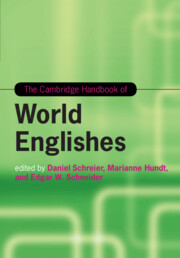Book contents
- The Cambridge Handbook of World Englishes
- Cambridge Handbooks in Language and Linguistics
- The Cambridge Handbook of World Englishes
- Copyright page
- Dedication
- Contents
- Figures
- Maps
- Tables
- Notes on Contributors
- 1 World Englishes: An Introduction
- Part I The Making of Englishes
- Part II World Englishes Old and New
- Part III Linguistics and World Englishes
- Part IV Current Challenges
- 25 Norms and Standards in World Englishes
- 26 Identity and Indexicality in the Study of World Englishes
- 27 The Politics of World Englishes
- 28 World Englishes in the Media
- 29 World Englishes and Transnationalism
- Index
- References
25 - Norms and Standards in World Englishes
from Part IV - Current Challenges
Published online by Cambridge University Press: 16 December 2019
- The Cambridge Handbook of World Englishes
- Cambridge Handbooks in Language and Linguistics
- The Cambridge Handbook of World Englishes
- Copyright page
- Dedication
- Contents
- Figures
- Maps
- Tables
- Notes on Contributors
- 1 World Englishes: An Introduction
- Part I The Making of Englishes
- Part II World Englishes Old and New
- Part III Linguistics and World Englishes
- Part IV Current Challenges
- 25 Norms and Standards in World Englishes
- 26 Identity and Indexicality in the Study of World Englishes
- 27 The Politics of World Englishes
- 28 World Englishes in the Media
- 29 World Englishes and Transnationalism
- Index
- References
Summary
The chapter discusses the notions of norms and standards in conceptualizing the evolutionary status of World Englishes. While “standard language” is the product of its functional and formal development in Haugen’s (1972) model, in Schneider’s (2007) model it is the status attained by a regional variety that has become endonormative. From the sociolinguistic perspective, the standard may be seen by its users either inclusively, as a uniting medium for the speech community, or exclusively, as an elevated reference style of English associated with correctness and an ideology of the standard. The norms of a variety can be induced from corpus data, showing how it has differentiated itself from the source variety. Two case studies illustrate the interplay between standards and norms. In both, there is grammatical evidence of the norms shifting away from their exonormative standards yet discomfort expressed in some quarters about the popular regional forms (Singlish, Taglish). Corpus evidence suggests that metalinguistic awareness of tension between Singlish and “good English” is stronger in Singapore than the equivalents in the Philippines, correlating with their evolutionary status.
Keywords
- Type
- Chapter
- Information
- The Cambridge Handbook of World Englishes , pp. 587 - 608Publisher: Cambridge University PressPrint publication year: 2020

